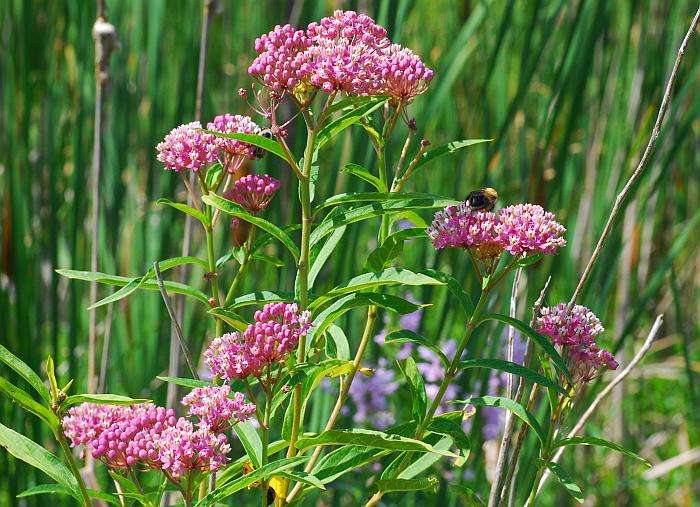Asclepias incarnata L.
Swamp Milkweed

Native
CC = 4
CW = -5
MOC = 78
© SRTurner
Asclepias incarnata L.Swamp Milkweed | |
 |
Native CC = 4 CW = -5 MOC = 78 |
© SRTurner |
|
Family - Asclepiadaceae Habit - Perennial forb from a fibrous rootstock. Stems - Ascending to erect, to 2 m, glabrous or hairy in longitudinal lines, with 6 to numerous nodes, usually branched in the inflorescence. Sap milky.
Leaves - Opposite, petiolate, simple. Petioles to 1.5 cm. Blades to 15 cm, 0.5-4.5 cm wide, narrowly lanceolate to ovate, the base abruptly narrowed or rounded, the tip gradually tapered to a sharp point, the margins flat or slightly curled under, glabrous or more commonly with the undersurface sparsely appressed-pubescent.
Inflorescence - Umbels, terminal and lateral (at the tips of short branches), short- to long-stalked, often several per plant, each with 10-40 flowers. Peduncles green, to 5 cm long, pubescent. Pedicels pinkish-rose, sparsely pubescent, to 1.4 cm long, subtended by linear bracts. Bracts to 6 mm long, pubescent.
Flowers - Calyx lobes 5, reflexed, short-hairy, 1.5-2.5 mm long, lanceolate to ovate. Corolla lobes 5, reflexed, glabrous, pink or rarely white, 4-6 mm long, elliptic to oblanceolate. Gynostegium appearing stalked (the column visible below the bases of the hoods), pale pink, rarely white, the corona slightly shorter than to about as long as the tip of the anther/stigma head. Corona hoods pinkish-white, 2.0-2.7 mm long, strongly ascending, attached near their bases, oblong-ovate in outline, the tips broadly rounded, the margins not toothed, the bases not pouched. Horns attached below the middle of the hoods, pinkish-white, extended conspicuously beyond the tips of the hoods and incurved over the anther/stigma head, linear, not flattened, tapered to a sharp point at the tip.
Fruits - Follicles 5-9 cm long, erect or ascending from erect or less commonly deflexed stalks, lanceolate in outline, the surface smooth, glabrous or minutely hairy. Seeds with the body 6.5- 9.0 mm long, the margins relatively broadly winged, the terminal tuft of hairs white.
Flowering - June - August. Habitat - Swamps, sloughs, marshes, pond margins, bottomland prairies, ditches. Origin - Native to the U.S. Lookalikes - None when flowering. Other info. - This attractive species is common throughout Missouri. It is found throughout most of the U.S., but is most common in the northeastern quadrant of the country and into Canada. When in bloom the plant is impossible to mistake for anything else. It is becoming one of the more popular milkweeds in cultivation due to its tall, graceful form, numerous pink inflorescences, and for the fact that it has few equals as an attractant for butterflies and other insects. It is one of the milkweeds which serve as host species for the monarch butterfly. It is a great choice for a sunny location with wet soil, and can thrive even in the wet patch at the end of a downspout. The plant is browsed by various mammals, and the roots are a food source for muskrats and other wetland animals.
Photographs taken in Brown Summit, NC., 10-12-02, and in the along the shores of the Current River, Shannon County, MO., 8-16-03 (DETenaglia); also at Busch Wildlife Area, St. Charles County, MO, 8-16-2008 and 10-10-2008; Weldon Spring Conservation Area, St. Charles County, MO, 7-31-2009; Klondike County Park, St. Charles County, MO, 8-2-2014 and 10-10-2021; Marais Temps Clair Conservation Area, St. Charles County, MO, 8-5-2021; and B. K. Leach Memorial Conservation Area, Lincoln County, MO, 9-13-2021 (SRTurner). |